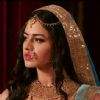**A NOTE TO ALL**
Hi everyone,
Welcome to the Mahabharata Discussion Thread.
As we all know, this show Karn Sangini is based on the bestselling mythological fiction Karna's Wife by Kavita Kane. Needless to say, like all fictional adaptations of the great Epic, the novel has its share of artistic liberties, interpretations and figments of imagination, which every author takes to provide a fresh perspective to the already-known tale. This goes without saying that Karn Sangini as a televised rendition would tread the same fictional path through creative liberties.
This topic has been created for the sole purpose of discussing the Classical Mahabharata, outside the fictional realm, whose authorship is attributed to Vyasa, along with comparative discussion of the regional variations/folklores. If you have any doubts or clarifications to make, then please post here. The rest of the forum would be reserved only for discussion related to the show. 😊
One humble request:
This thread is not for Karna vs Arjun marathons. So, please keep it strictly for learning, clarifications, constructive discussion and knowledge sharing purpose only, such as variations of Mahabharata, Canon vs Folk Traditions, constructive analysis/critique of characters, events or authors, various Commentaries, etc beyond what we already know. Please avoid making any kind of instigating comments, and also refrain from fanwars, opinionated fanaticism, personal jibes, abuses, chit-chatting between fans of single characters, etc. 😊
***
What is Mahabharata?
We have all grown up reading or hearing some version of Mahabharata. But most of the times, our exposure of the epic is limited to condensed abridged versions like Amar Chitra Katha, TV series, fictional takes like Karna's Wife, famous works of poetry on selected incidents or characters by stalwarts like Tagore, Ramdhari Dinkar, etc. And then, there are those wondrous stories we have heard from our grandparents. My exposure to Mahabharata began from Upendrakishore Raychaudhuri's kiddish Bengali version, when I was a school kid!
Mahabharata, in its unabridged form, however is very different and far more nuanced than what we have grown up reading. We often wonder:
Is Mahabharata history? Is it entirely fiction? Is it fiction based on History? If it is history, then when exactly did the events take place?
Owing to lack of concrete archeological evidence of the Kurukshetra War, different scholars and academicians have given their own ideas about the Epic in their respective pieces of work. Traditionalists (and Indians, in general) prefer to believe Mahabharata was our unadulterated History or itihaas (as it calls itself), whereas Western school of thoughts inclines more towards the term "mythology" to classify our Epics.
Whether we accept their theories is a matter of our personal belief. But one thing seems to be clear. All these ancient scholars or modern academicians viz. Devabodha, Arjunamisra, Nilkantha Chaturdhara, or more recent Vishnu S. Sukthankar, Prof. Nrishingho Prasad Bhaduri, P.P.S. Shastri, Kevin Mcgrath, John Brockington, Alf Hiltebetel, etc. follow some basic manuscripts which is considered "canon" by them. Of course, there are variations in these manuscripts across the length and breadth of the country, but the basic crux and character arcs surprisingly retain the same characteristics, as pointed out by Prof. Bhaduri in his article here. https://www.telegraphindia.com/7-days/coming-soon-the-mahabharat-mahaproject/cid/1315858.
Regarding the history of the text:
What is the definition of "canon" for a text as old as Mahabharata?
Surely, it is difficult to define, though not impossible to form a rough idea about.
Mahabharata, as we know it in the Indo-Vedic context, came down to us in two distinct categories: Northern Recension (NR) and Southern Recension (SR). NR refers to the North Indian manuscripts of the epic, and SR refers to those which were found in the Southern part of the country. Many of these manuscripts were collated into Editions by various scholars coming from various geographical locations in the past few centuries. As per my knowledge, we have currently, 9 prominent Editions of Mahabharata, of which 6 belong to NR and 3 to SR, that roughly form the "canon" of Mahabharata.
(1) The Calcutta Edition, created by Asiatic Society, 4 volumes, 1834-39.
(2) The Bombay edition, printed in 1863, also called Nilkantha Chaturdhara's commentary Bharatabhavadipa (originally composed in17th Century.)
(3) The Burdwan Edition, published under the auspices of the Maharajadhiraj Mahtabchand of Burdwan, in original Sanskrit around 1863
(The much-known K.M. Ganguly's English translation was a combination of Edition (2) and (3) as mentioned by the Translator himself in his Preface. )
(4) The Madras edition, re-edited with tika by Nilakantha Govinda, 1890.
(5) The Southern Edition, 18 volumes, critically edited by P.P.S. Shastri,and published by Ramaswamy Sastrulu & Sons, Madras, 1932.
(6) The Poona Recension (collated by Bhandarkar Oriental Research Institute or BORI) from 1927-65. Though this is a single Edition, it is a collation of maximum number of manuscripts of Mahabharata found in the Indian subcontinent. As a result, it is considered by many as the most authoritative and the first Critical Edition, completed in 1966. This is translated in English by Bibek Debroy, and in Hindi by S.D. Sadwalekar.
(7) Earlier edition of the Southern Recension, from the Vani Vilasa Press, Srirangam.
(8) The Gorakhpur Edition, translated in Hindi by Gita Press, 8vols.
(9) Edition in Bengali characters, Panchanan Tarkaratna, Bangabasi Press, 2 folio vols.
Southern Recension did not enjoy the same limelight as the Northern Recension. Post the medieval era, we find increasing interest in the scholarly circle to translate Mahabharata. But for some reason, all legit English translations, viz. KMG, M.N. Dutt, Clay Edition, etc were done for NR. As a result, most of us have remained oblivious to the Southern Edition of the Epic, which, according to Sukthankar (General Editor of BORI), is far more systematic and poetically superior than its Northern counterpart (See Prolegomena, link below).
It is difficult to trace when exactly the Mahabharata (as a poem) was composed. Traditionally, it is attributed to sometime around 3000 B.C. It is also believed that the story composed by Veda Vyasa was recited to Lord Ganesha, and this composition was transferred down orally for centuries through the Smriti tradition by bards or Sutas, till it came to be written down sometime in the Gupta Period for the first time by the Brahmanical sects.
While the concept of oral tradition of the canon text is now being challenged, one thing is clear; the story has undergone various modifications. And yet, it has retained the basic components that lead scholars to believe that all the different versions descended from one Mother Source. The preserved texts are believed to be not older than 400 BC, though we have references from Panini and Chanakya's works to the various characters of the epic from 2nd to 6th Century BC, indicating that the story was much older. Having said that, Mahabharata is believed to have received its final form sometime around 400 AD (as per Debroy's Preface to the Critical Edition).
Retellings and Adaptations of Mahabharata:
In this context, it is important to talk about the various Retellings of the Epic. While the "canon" texts were being written down, and the control over the Epic passed over to the Bhargav Brahmins from the Sutas, we see a gradual rise in various regions of the country to retell and adapt the Epic into various regional languages. This retelling culture began from sometime around 10th to 12th Century AD in South India, and spread its wings till Bengal. Indologist Pradip Bhattacharya opines that the reasons for this remarkable emergence could be attributed "to the felt need to assert the indigenous identity in the context of the Muslim invasion, but this calls for further study".
These regional retellings are not to be mistaken with the Sanskrit "canon". These were written in simpler languages, and were filled with beautiful artistic liberties of the various poets and bards who composed them. This is because, these adaptations were targeted for the uneducated peasantry, and with the noble intention to introduce our Epics to the general masses in an easier format. With the passage of time, the common people began to be more accustomed to these simpler retellings, and thus, stories from these adaptations got etched into the public psyche.
Some of the most popular retellings on Mahabharata are Mahabharata by Kashiram Das (Bengal, 17th Century), Villi Bharatham by Villiputtur Alwar (Tamil Nadu, 14th Century), Sarala Das' Oriya Mahabharata (15th Century), etc. These works are often mistaken to be verbatim translations of the Sanskrit canon, though they were basically adaptations, replete with original ideas of the respective poets. These original ideas of poets like Kashiram, etc are now mistakenly attributed to Vyasa.
Folk Traditions on Mahabharata:
Mahabharata has a rich Folk Culture in various parts of our country. These were mostly oral by nature, and developed in mainly rural or tribal areas of the Indian subcontinent. These Folk Traditions are very different from the canon stories, and beautiful through their rustic simplicity and symbolism. Some of the well-known folk traditions are those of the Bhils, Garhwal Himalayas, Gingi Cult, etc.
This, in short, is the evolution of Mahabharata in the Indo-Vedic context. (I am leaving out the Jain, Buddhist, Javanese, Indonesian variations, for now).
***
References, Sources and Links:
If one is interested to explore Mahabharata in its unabridged form, then please check below:
1.) To read the Critical Edition of Mahabharata (BORI) in English translated by Bibek Debroy, (along with Harivamsa which is onsidered the Appendix to Mahabharata):
2.) To read the Critical Edition of Mahabharata in Hindi: https://archive.org/details/Mahabharata_with_Hindi_Translation_-_SD_Satwalekar/page/n7
3.) To know about the details of Mahabharata Editions, and the making of the Critical Edition, read "Prolegomena to the Adi Parva" by V.S. Sukthankar, General Editor of BORI.
http://gretil.sub.uni-goettingen.de/gretil_elib/Suk933__Sukthankar_ProlegomenaMBh1.pdf
4.) To read the complete Gita Press' Gorakhpur Edition in Hindi, please see here:
https://nyktrivedi.wordpress.com/2012/08/02/mahabharat-sanskrit-to-hindi-gita-press/
5.) To read K.M. Ganguly's translation: http://www.sacred-texts.com/hin/maha/index.htm
6.) The information given above are extracted from various difference commentaries on Mahabharata such as:
i.) Prolegomena to the Adi Parva and other works of V. Sukthankar.
ii.) The Sanskrit Epic by J.L. Brockington
iii.) The History of Classical Sanskrit by M. Krishnamachariar
7.) Repositories of different versions, summaries, commentaries ever written on Mahabharata:
i.) http://www.dvaipayana.net/
ii.) http://www.mahabharata-resources.org/
iii.) Blog articles of Indologist Pradip Bhattacharya and Satya Chaitanya.
Thanks & Regards,
Amrita T























comment:
p_commentcount